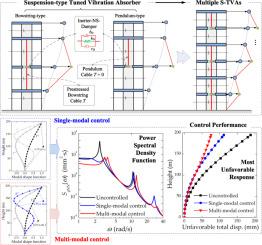多悬挂式调谐减震器的多模式响应控制
IF 7.1
1区 工程技术
Q1 ENGINEERING, MECHANICAL
International Journal of Mechanical Sciences
Pub Date : 2024-10-17
DOI:10.1016/j.ijmecsci.2024.109775
引用次数: 0
摘要
由于复杂的激励,工程结构经常会受到多模态响应的影响。考虑到在细长结构上实际安装的可行性,研究了用于多模态响应控制的多个悬挂式调谐减振器(S-TVA)。首先,对用于单模态响应控制的单个 S-TVA 的参数优化进行了分析研究。解决了有关优化调整、静态和动态性能以及安装位置的问题。随后,介绍了使用多个 S-TVA 进行多模式响应控制的优化设计方法。讨论了优化策略的两个方面。因此,优化应采用反模态顺序序列。此外,模态信息应根据上一步优化的 S-TVA 进行更新。最后,通过对细长烟囱进行实际的风致响应控制,验证了所提出的优化设计方法的有效性。最不利响应的抑制率可达 59.7%,比传统的单一模式控制方法高出 47.8%。此外,有趣的是,实际的整体控制性能可能无法直观地通过更多的控制模式来实现。建议从所提出的优化设计方法确定的几个实际案例中进行选择。实际安装和可行性是实践中必须考虑的重要因素。本文章由计算机程序翻译,如有差异,请以英文原文为准。

Multi-modal response control with multiple suspension-type tuned vibration absorbers
Due to complicated excitations, engineering structures are often subjected to multi-modal responses. Considering the feasibility in practical installation on slender structures, multiple Suspension-type Tuned Vibration Absorbers (S-TVAs) are investigated for multi-modal response control. Firstly, parametric optimization of a single S-TVA for single-modal response control is investigated analytically. The issues regarding to the optimal tuning, static and dynamic performances, and installation location are addressed. Subsequently, an optimal design method for multi-modal response control with multiple S-TVAs is presented. Two aspects on the optimization strategy are discussed. Consequently, the optimization should be performed with an inverse modal order sequence. And, the modal information should be updated considering the S-TVA optimized in the previous step. Finally, the effectiveness of the presented optimal design method is validated through practical wind-induced response control on a slender chimney. The most unfavorable response can be suppressed up to 59.7 %, which is 47.8 % better than traditional single-modal control approach. Moreover, it is interesting to find that the practical overall control performance may not be achieved with more controlled modes intuitively. It is recommended to select from several practical cases determined by the presented optimal design method. Practical installation and feasibility are highly required to be considered in practice.
求助全文
通过发布文献求助,成功后即可免费获取论文全文。
去求助
来源期刊

International Journal of Mechanical Sciences
工程技术-工程:机械
CiteScore
12.80
自引率
17.80%
发文量
769
审稿时长
19 days
期刊介绍:
The International Journal of Mechanical Sciences (IJMS) serves as a global platform for the publication and dissemination of original research that contributes to a deeper scientific understanding of the fundamental disciplines within mechanical, civil, and material engineering.
The primary focus of IJMS is to showcase innovative and ground-breaking work that utilizes analytical and computational modeling techniques, such as Finite Element Method (FEM), Boundary Element Method (BEM), and mesh-free methods, among others. These modeling methods are applied to diverse fields including rigid-body mechanics (e.g., dynamics, vibration, stability), structural mechanics, metal forming, advanced materials (e.g., metals, composites, cellular, smart) behavior and applications, impact mechanics, strain localization, and other nonlinear effects (e.g., large deflections, plasticity, fracture).
Additionally, IJMS covers the realms of fluid mechanics (both external and internal flows), tribology, thermodynamics, and materials processing. These subjects collectively form the core of the journal's content.
In summary, IJMS provides a prestigious platform for researchers to present their original contributions, shedding light on analytical and computational modeling methods in various areas of mechanical engineering, as well as exploring the behavior and application of advanced materials, fluid mechanics, thermodynamics, and materials processing.
 求助内容:
求助内容: 应助结果提醒方式:
应助结果提醒方式:


